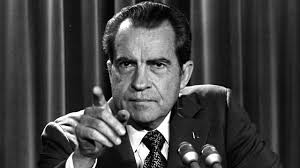Imagine turning on your TV on a quiet Sunday evening in August 1971. There’s President Richard Nixon, sitting calmly at his desk, looking serious. You’re expecting another update on the economy—maybe something about jobs or inflation.
But instead, he drops a bombshell that redefines money itself:
“I have directed the Secretary of the Treasury to suspend temporarily the convertibility of the dollar into gold…”
Wait… what?
Just like that, the promise that had defined global finance for generations—that you could exchange U.S. dollars for real, shiny gold—was over.
This wasn’t just an economic policy shift. It was the moment money changed forever.

So, What Led to This Shocking Announcement?
To understand why Nixon pulled the plug on gold, we have to rewind a bit. The Bretton Woods system, born in 1944, made the U.S. dollar the center of the financial universe. Other countries tied their currencies to the dollar, and the dollar was backed by gold. Sounds neat and stable, right?
But by the late 1960s, the cracks were showing.
💵 America Was Printing Money Like There Was No Tomorrow
The U.S. had expensive bills to pay—Vietnam War, social programs, Cold War spending—and it was printing more dollars than it had gold to back them up.
🌍 Other Countries Started Getting Nervous
Nations like France and West Germany looked at their growing piles of dollars and thought, “Hmm… maybe we should cash these in for gold before the U.S. runs out.”
And that’s exactly what they started doing.
🏦 Fort Knox Was Bleeding Gold
By 1971, the U.S. gold reserves were draining fast. If things kept going like this, America might be left with paper promises and no gold at all.
So Nixon did the unthinkable.
The “Temporary” Move That Changed Everything
On August 15, 1971, Nixon said the suspension of gold convertibility was temporary—but let’s be honest, it was a breakup with gold that was never getting patched up.
🪙 From Gold-Backed to Trust-Based
From that day on, the dollar—and every currency tied to it—was no longer anchored to anything physical. It was now a matter of faith, backed by government authority and public confidence.
🌊 The Global Economy Started Floating
With no more fixed link to gold, currencies were set free to float. Exchange rates began to rise and fall based on market forces, speculation, and political shifts.
A whole new era of finance had begun.
Was This Brave or Reckless?
Well, that depends on who you ask.
🔹 Some say Nixon saved the global economy from collapse. The gold standard was too rigid for a modern, growing, post-war world.
🔹 Others believe he opened Pandora’s box, letting loose decades of inflation, credit bubbles, and currency manipulation.
Either way, this bold move unchained money from metal—and nothing was ever the same.
Why This Moment Still Matters Today
Think about it:
💳 Every dollar you’ve ever earned, saved, or spent since 1971 exists because people believe in it, not because it’s backed by gold.
🏦 Central banks today can print trillions of dollars with the click of a mouse—something unthinkable in the gold-backed days.
📈 Our entire financial system, from mortgages to markets to crypto, is built on the world that Nixon’s decision helped create.
August 15, 1971 wasn’t just an economic shift. It was the end of one world and the beginning of another.
